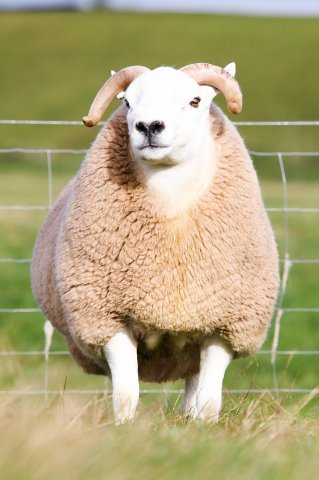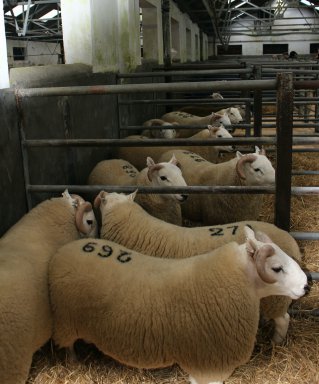

Description Of a Cheviot Tup
By Wm. Thompson Hall
March 1898
His nostrils and nose should be open and wide,
That he may “roll through them the breath of his pride;”
They also must be of the hue of the sloe,
And his face should be white as the new driven snow.
His jaws must be strong, sitting squarely together,
To give him fair play at the stool bent and heather.
‘Twixt his bright looking eyes there must be a wide space,
For nothing is worse than a long narrow face;
Then they must be prominent, sparkling, and clear.
Let the crown of his head be well covered with hair –
Not coarse like pigs’ bristles, not silk like your hat,
But fine, white, and hard, lying level and flat.
His small shapely ears must no coarse thickness show,
For this is a fault, as all tup breeders know;
To the tips have them covered with fine hard white hair,
And be certain that no tender redness is there;
He must bear them erect, not let them hang down
Like a docken tied on each side of his crown.
His neck should be muscular, full fleshed, and strong,
By no means too short, nor yet over long.
It should form with his back an angle obtuse;
If straight out or low down ‘tis a matter of use.
Well back from his full breast his shoulders must lie,
And two things thereanent you should keep your eye.
First of all have them formed that his action may be
Unimpeded, not rolling, but perfectly free.
Then they must have substance good mutton to grow,
As sheep are for profit as well as for show.
His back should be level and broad, not too long,
Not concave nor convex, but straight, firm, and strong;
Well covered with mutton, for everyone knows
That the back is the place where the finest meat grows;
It must also be mellow and ripe all along;
If you feel any hardness, be sure something’s wrong.
His full square hindquarters must be of good length,
With plenty of substance and plenty of strength.
They must be quite straight, with no droop down behind,
For this is a fault of the very worst kind.
His strong, handsome tail must be firmly set on;
We’ll have more to say on that subject anon.
His ribs must be well sprung in every part –
Giving plenty of room for his lungs and his heart;
For his wind must be good, as well as his gait,
When he goes in November the shed ewes to mate.
Besides being well sprung, his ribs must be deep;
Short ribs are a very great fault in a sheep.
Let his gigot be large, ‘tis a very good thing.
A joint, indeed, fit every way for a king;
Let it be full and wide, with plenty of scope
To hold in its centre the “eye of the Pope.”
The next thing about him that we have to note
Is the quality, style, and strength of his coat;
But now to describe it, or where to begin,
Is no easy matter about a sheep’s skin;
For many good judges have different views
As to what kind of tups will cross best with their ewes.
Much also depends on the kind of his keep,
Which very soon alters the coat of a sheep;
But there are certain rules which always hold good,
And which by all breeders are well understood.
His fleece when you grip it must fill your hand full
Of the finest, the soundest, the closest of wool;
Not a hair must be seen, no coarse benty locks,
All must be of good quality down to his hocks.
There must be no purl, let each fibre be straight,
Assuring the requisite style and good weight;
While up to his cheeks and his ears and his throat
No bareness at all must appear in his coat:
Well down to his knees let the wool nicely grow,
And be sure that he’s properly covered below.
Bear also in mind that his belly and breast
Must grow no white hair, but good wool like the rest;
From the hair on his crown, right to his tail-end,
All over his body good wool must extend.


And, when he is bared clipped in the middle of May,
His fleece should make out the fourth part of a weigh.*
His legs must be clean, flat, and broad, of fair length,
Combining the finest of bone with great strength;
They must also be covered with short, hard, white hair,
And no rough, coarse redness at all should be there.
Strong, springy, and sloping pasterns must be:
If short and upright, he’ll ne’er walk properly.
Come we now to his feet, the last thing of all.
They must not be contracted, nor round like a ball,
But black and well shaped, of the orthodox kind,
All fairly set on, both in front and behind.
Then there is a matter deserving our care –
His legs from his body must stand firm and square;
While our sheep, being wide at the breast and the heart,
Should have his four legs at good distance apart.
When these things are all right, there still is a fact
We should always remember – he must be compact.
About his form, standing, we’ve had a long talk,
So now we will move him, and see how he’ll walk.
He will step freely out, as straight as a die,
Not trailing his feet, not stepping too high;
With grace in each movement, not rolling about,
Nor twisting his legs either inwards or out.
So true in his action, so smooth in his gait,
His tail will scarce move, but hang down almost straight.
His air self-reliant, he walks with such grace,
You might think he was monarch of all he surveys.
There is an old saying – its meaning is clear –
He must stand for a fortnight, and ne’er shed a tear
At a snow wreath in winter, if such be his fate;
His “front still unaltered, his courage elate.”
For in many ways sheep are just like mankind,
If they’re lacking in courage, they’re always behind.
We have tried to describe him, but howe’er we try,
There is always about him un Je sais quoi,
Which, to know, must be seen, for no one can state
All the fine subtle points of his style and gait;
But his look will be such that a tyro can see
He is no common sheep, but of high pedigree.
*A weigh is equal to 48lbs
